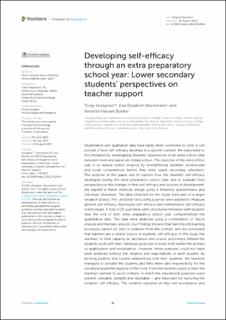Developing self-efficacy through an extra preparatory school year: Lower secondary students’ perspectives on teacher support
Peer reviewed, Journal article
Published version

View/
Date
2022Metadata
Show full item recordCollections
- Artikler [407]
- Publikasjoner fra Cristin [424]
Abstract
Quantitative and qualitative data have rarely been combined to offer a rich portrait of how self-efficacy develops in a specific context. We responded to this limitation by investigating students’ experiences of an extra school year between lower and upper secondary school. The objective of the extra school year is to reduce school dropout by strengthening students’ professional and social competences before they enter upper secondary education. The purpose of this paper was to explore how the students’ self-efficacy developed during the extra preparatory school year and to evaluate their perspective on the changes in their self-efficacy and sources of development. We applied a mixed methods design using a threefold questionnaire and individual interviews. The data collected for this study were part of a larger research project. Pre- and post-tests using a survey were applied to measure general self-efficacy, Norwegian self-efficacy and mathematics self-efficacy in individuals. A total of 23 qualitative semi-structured interviews with students near the end of their extra preparatory school year complemented the quantitative data. The data were analysed using a combination of Rasch analysis and thematic analysis. Our findings showed that learning and learning processes cannot be seen in isolation from the context, and we concluded that teachers are a central source of students’ self-efficacy. In this study, the teachers, in their capacity as facilitators and source performers, helped the students work with their individual purposes in mind, both within the domain of qualification and socialisation. However, these purposes could not have been achieved without the initiative and responsibility of each student. By building positive and trustful relationships with their students, the teachers managed to activate the students and help them take responsibility for the social and academic aspects of their lives. From the students’ point of view, the teachers seemed to build contexts in which the educational purposes were present, viewable, sensible and reachable – and important for nurturing the students’ self-efficacy. The students reported on their self-acceptance and feeling of belonging, being forward-looking and being able to portray their future selves as a consequence of mastering their academic disciplines. This study offers a methodological contribution in that we combined quantitative and qualitative data to analyse the students’ self-efficacy. The qualitative data allowed for a more comprehensive understanding of the students’ increased self-efficacy than that derived from the quantitative data alone. Keywords: self-efficacy, dropouts, sources of self-efficacy, teacher’s role, mixed methods, thematic analysis, Rasch analysis
